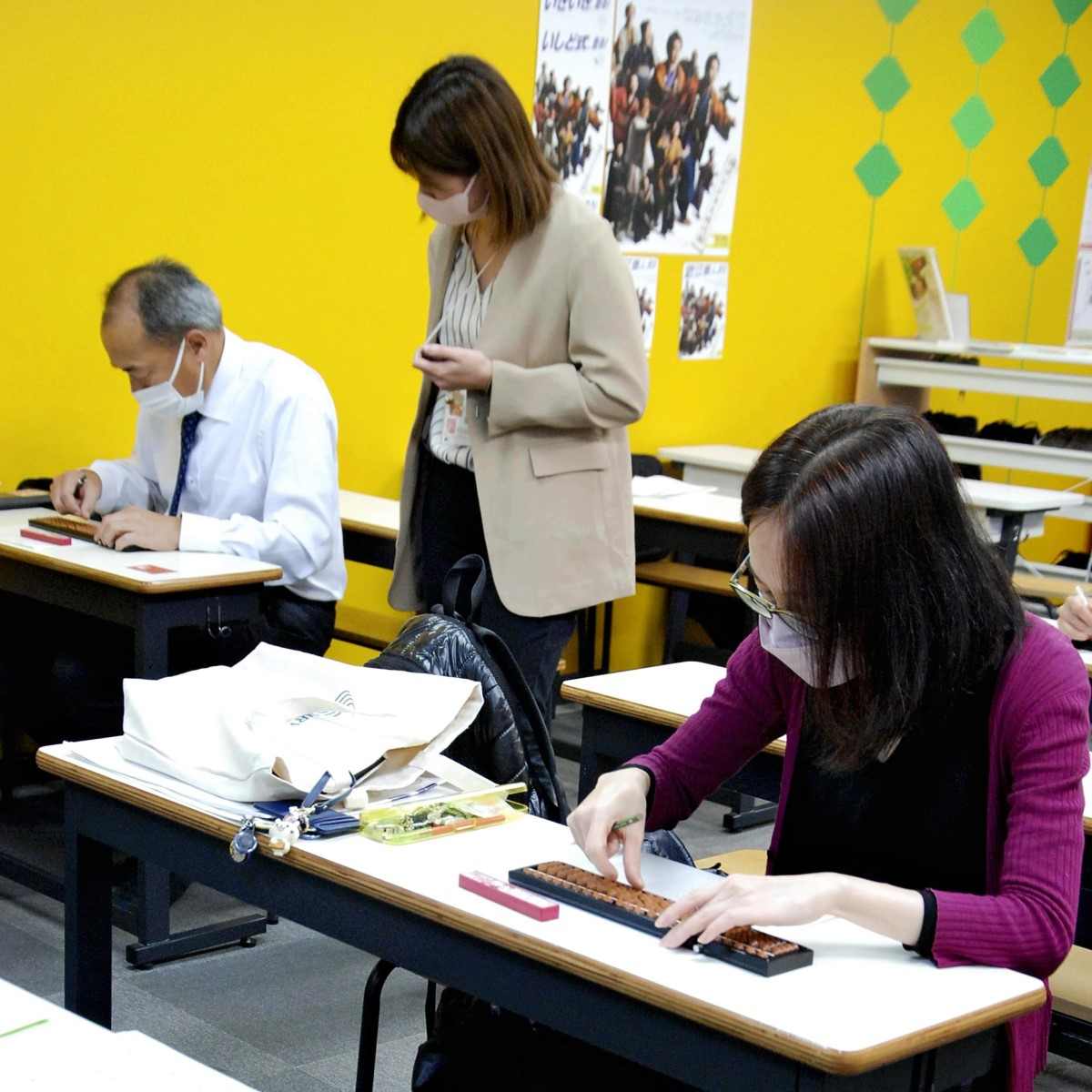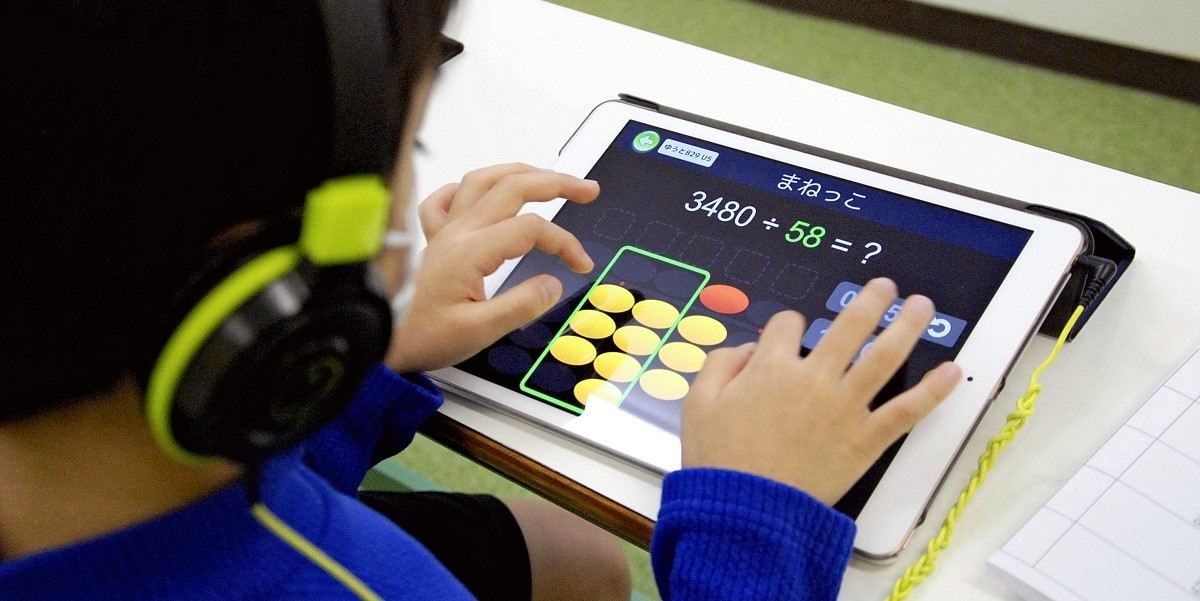
Adult students operate abacuses in a class in Chuo Ward, Tokyo.
10:51 JST, January 24, 2023
The abacus, which is called soroban in Japanese and used to be one of popular out-of-school learning activities for children, is once again drawing attention, with some adults relearning it because it is useful for their work. In an age when all we have to do to calculate a sum is open our smartphone, is the abacus really necessary?
“Go!” At the teacher’s shout, students started operating their abacuses at Higashi-Nihonbashi School of Ishido Shuzan Gakuen in central Tokyo, shortly after 7 p.m. on Dec. 1 last year. They included office workers who had come after work.
They moved the beads to do multiplication and division, making tapping sounds. At the end of the class, the students did mental arithmetic as their teacher read figures aloud. “Now to begin: there is ¥671, there is ¥940, there is a subtraction of …” The students listened to the teacher’s voice, closing their eyes and moving their fingertips in the air.
Hidemi Kurohara, 58, who joined the class two years ago and works for a major manufacturer, said: “I can now calculate in my head while listening to what others are saying during discussions on budgets and other matters. I am the first to notice mistakes in the numbers on resumes,” he laughed.
This school in Higashi-Nihonbashi opened in 2014. According to Ishido, a Chiba Prefecture-based company that operates a chain of soroban schools, the initial classes were mainly for children, but the number of adult students who wanted to make use of soroban skills for their work increased, so the company began a class exclusively for adults in 2016.
In Ozora Pass, an online abacus class launched in July 2020, adult students account for 40% of the total. Instructor Hidenari Negishi said, “Many of our students want to become good with figures and gain trust in business settings.”
According to the Economic Census of the Statistics Bureau of Japan and other sources, there were 13,010 abacus schools nationwide in 1986, but by 2016 the number had halved to 6,446, due to the spread of calculators and the aging of instructors. However, the margin of decline has been shrinking, and in recent years, abacus schools touting the effect on mental calculation and right-brain development have been growing.
Kikunori Shinohara, a professor of brain science at Suwa University of Science, said: “Soroban will activate the brain and train working memory, which holds information temporarily and processes it. It is useful for children to develop this ability and for adults to maintain it.”
Takeshi Hatta, president of Kansai University of Welfare Sciences, explained: “When doing mental calculation with figures written on paper, you mainly use the left brain, which deals with figures. But when you do a soroban-style mental calculation, you also use the right brain, because you picture the beads of the abacus in your mind while calculating. Since images hold more information than letters and are easier to memorize, you will become able to do complex calculations quickly.”
While importance is being placed on science-related subjects — as seen by programming becoming a required subject at school — children’s dislike of arithmetic is persistent. Fusao Takahashi, secretary general of the national association for abacus education, said, “An increasing number of parents are taking an interest with an eye toward entrance exams [for their children].”
Meanwhile, a class that attempts to improve children’s mental calculation ability by combining the functions of an abacus and IT is gaining popularity. SoroTouch, a mental calculation training method using a tablet instead of an abacus, is a service operated by Digika Co., based in Tokyo. Learners touch the beads displayed on the screen and check for color changes in the beads as they calculate, strengthening their mental arithmetic ability.
Chairwoman Chika Yamauchi was formerly a bank employee. She started the service in 2016 as she knew that traders dealing with financial products were good at mental calculation and were depended upon in workplaces. Currently, there are more than 200 classes being run in Japan and abroad, she said.
Hideo Kageyama, former head of the Osaka Prefectural Board of Education, said, “Thoroughly repeated practice of the basics will help to raise not only calculation and mental arithmetic skills, but also reading comprehension and concentration. An electric calculator is a tool for accurate calculation, but an abacus is a tool for improving human ability itself.”

A student uses the SoroTouch app to calculate by touching the beads displayed on a tablet screen, in a class in Chiyoda Ward, Tokyo.
More than 100 countries
The abacus is said to have originated in the Mesopotamian civilization 4,000 years ago. It was introduced from the West via the Silk Road to China, where the prototype of today’s abacus was created, which consists of rows of movable beads sliding on rods.
The abacus was introduced to Japan in the 16th century during the Muromachi period. It became popular during the Edo period along with the development of commerce and the prosperity of terakoya private elementary schools. Learning to use an abacus became a required subject at elementary schools under the old educational system in 1935. Today, it is still taught in third- and fourth-grade arithmetic classes at elementary schools.
According to the national association for abacus education, the abacus is taught in more than 100 countries around the world. The world’s largest operator of abacus schools, UCMAS, headquartered in Malaysia, aims to develop concentration and ability to memorize through the acquisition of mental calculation skills and boasts more than 1 million students in the United States, Europe and elsewhere.
"Society" POPULAR ARTICLE
-

M4.9 Earthquake Hits Tokyo, Neighboring Prefectures
-

Israeli Tourists Refused Accommodation at Hotel in Japan’s Nagano Pref., Prompting Protest by Israeli Embassy and Probe by Prefecture
-

M7.5 Earthquake Hits Northern Japan; Tsunami Waves Observed in Hokkaido, Aomori and Iwate Prefectures
-

Tsukiji Market Urges Tourists to Avoid Visiting in Year-End
-

High School in Kyoto Says Students Shoplifted during Recent School Trip to Bali, Indonesia
JN ACCESS RANKING
-

Tokyo Economic Security Forum to Hold Inaugural Meeting Amid Tense Global Environment
-

Keidanren Chairman Yoshinobu Tsutsui Visits Kashiwazaki-Kariwa Nuclear Power Plant; Inspects New Emergency Safety System
-

Imports of Rare Earths from China Facing Delays, May Be Caused by Deterioration of Japan-China Relations
-

University of Tokyo Professor Discusses Japanese Economic Security in Interview Ahead of Forum
-

Japan Pulls out of Vietnam Nuclear Project, Complicating Hanoi’s Power Plans

























